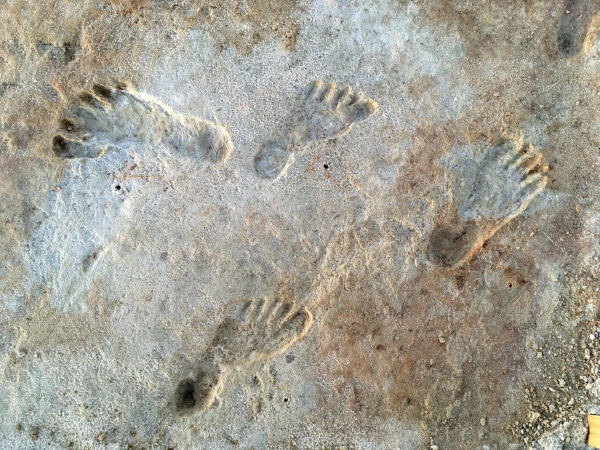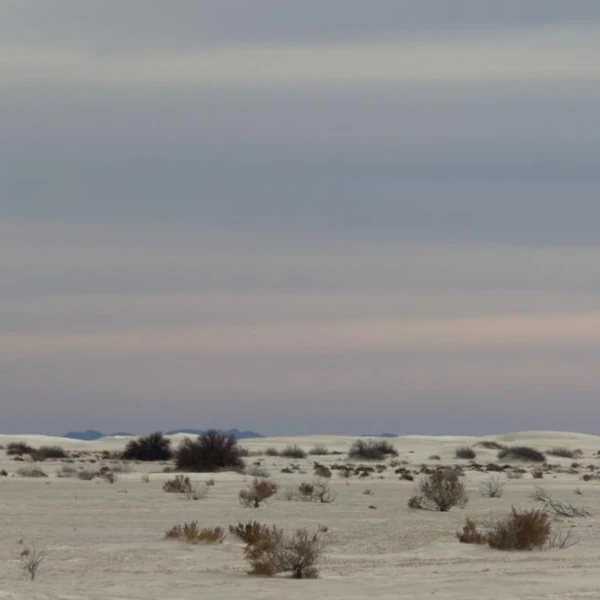
In 2021, a team from the USGS revealed a major discovery: perfectly preserved human footprints in the gypsum of the White Sands basin, New Mexico. These tracks, dated using radiocarbon (14C) dating, go back about 23,000 years, predating the traditionally accepted human colonization of the Americas (around 13,000 years for the Clovis culture) by several millennia.
These footprints likely belonged to adolescents and children moving along an ancient lakeshore during a cold and humid climate at the Last Glacial Maximum.
N.B.:
The carbon-14 method is based on the radioactive decay of the isotope \(^{14}\mathrm{C}\), present in organic tissues as long as they exchange carbon with the atmosphere.
Upon the organism's death, this exchange stops, and the decay of \(^{14}\mathrm{C}\) follows an exponential law with a half-life \(T_{1/2} = 5730 \pm 40\) years.
By measuring the remaining \(\frac{^{14}\mathrm{C}}{^{12}\mathrm{C}}\) ratio in a sample, its age can be estimated up to about 50,000 years.
This technique, developed by Willard Frank Libby (1908-1980), is based on the general principle of decay kinetics and requires corrections for variations in atmospheric \(^{14}\mathrm{C}\) levels over time.

The White Sands site is located in a vast evaporation plain formed by the drying of Lake Otero. The white sediment, rich in gypsum, has allowed the exceptional preservation of footprints. These are imprinted in alternating layers of mud and volcanic ash.
Recrystallized gypsum formed a natural mold preventing erosion. Thanks to fine stratigraphy and the dating of ruppia seeds found in the same layers, researchers were able to estimate the precise chronology of these human movements.
N.B.;
In the United States, the term "National Monument" designates a territory protected by presidential proclamation under the Antiquities Act of 1906.
Before this discovery, the dominant theory held that the first humans in America crossed the Bering Strait after the melting of the glaciers, around 13,000 years before our era. The White Sands footprints challenge this timeline.
They suggest a human presence at least 10,000 years earlier, implying arrival by coastal route or pre-glacial migration.
This hypothesis aligns with the work of Ruth Gruhn (1921-2021), an anthropologist who long argued for an earlier coastal settlement of the Americas.
Metric and morphological analysis of the footprints reveals lengths between 20 and 24 cm, indicating individuals of average height, likely aged 10 to 15 years.
Researchers modeled the pressure exerted on the substrate from the depth of penetration: \[ P = \frac{F}{S} \] where \(F\) is the force exerted by body weight and \(S\) is the contact area of the foot.
Variations in \(P\) indicate walking speeds of about 1.7 m/s, typical of a brisk walk. These data are compared to animal tracks (giant sloths, mammoths) also present, revealing direct interactions between humans and megafauna.
The White Sands footprints provide direct, not just archaeological, evidence of human presence during the Late Pleistocene. They are part of a growing body of evidence: lithic tools from Chiquihuite (Mexico), bones from Bluefish Caves (Canada), or traces of ancient hearths in Chile (Monte Verde).
This convergence suggests that modern humans reached America long before the end of the last ice age and coexisted with megafauna until their gradual extinction around 10,000 years ago.
N.B.:
The Late Pleistocene corresponds to the final part of the Pleistocene, extending approximately from 126,000 to 11,700 years before our era.
This period is characterized by significant climatic fluctuations, including the Last Glacial Maximum (~26,500 to 19,000 years BP), which led to the expansion of continental glaciers, a drop in sea levels, and changes in terrestrial and marine ecosystems.
The Late Pleistocene is also crucial for the study of modern human evolution and the colonization of continents, as it coincides with the appearance and dispersal of Homo sapiens populations out of Africa and coexistence with now-extinct megafauna.
| Site | Location | Estimated Dating | Comment |
|---|---|---|---|
| White Sands | New Mexico, USA | ~23,000 years BP | Fossilized human footprints; direct evidence of pre-Clovis presence |
| Bluefish Caves | Yukon, Canada | ~24,000 years BP | Human-worked bones; habitat during the Last Glacial Maximum |
| Monte Verde | Chile | ~14,500 years BP | Remains of human campsites; first evidence of South American settlement |
| Cueva de Chiquihuite | Mexico | ~26,000 years BP | Lithic tools not associated with direct fossil remains |
| Meadowcroft Rockshelter | Pennsylvania, USA | ~16,000 years BP | Pre-Clovis tools; evidence of earlier human occupation than expected |
| Page-Ladson | Florida, USA | ~14,500 years BP | Footprints and lithic tools in freshwater; fluvial context |
| Paisley Caves | Oregon, USA | ~14,000 years BP | Human remains and artifacts; evidence of seed consumption |
| Lehner Ranch | Arizona, USA | ~12,000 years BP | Clovis site; remains of hunted megafauna |
| Folsom | New Mexico, USA | ~10,800 years BP | Folsom culture; evidence of hunting weapons and megafauna |
| Calico | California, USA | ~200,000-130,000 years BP | Controversial artifacts; supposed ancient human occupation |
| Cooper’s Ferry | Idaho, USA | ~16,000 years BP | Pre-Clovis; lithic tools and hearth remains |
| Manis Mastodon | Washington, USA | ~14,000 years BP | Mastodon bone pierced by a wooden spear; human-megafauna coexistence |
| Cerutti Mastodon | California, USA | ~130,000 years BP | Fractured mastodon bones; controversial human occupation |
Source: United States Geological Survey (USGS), Smithsonian Magazine, Nature, 2020.